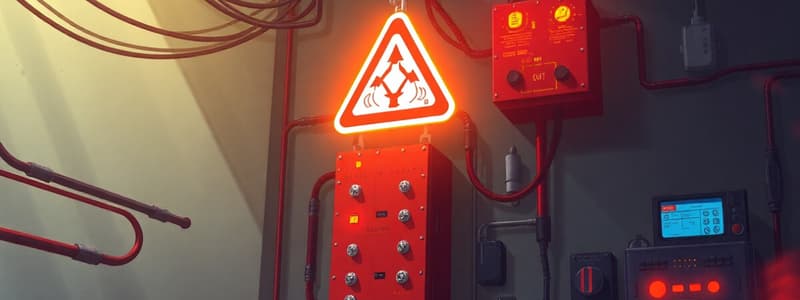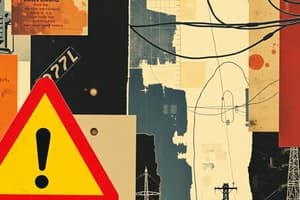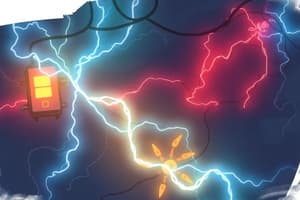Podcast
Questions and Answers
What is the highest temperature an electric arc can reach?
What is the highest temperature an electric arc can reach?
- 5,000°C
- 10,000°C
- 20,000°C (correct)
- 15,000°C
What is considered the primary cause of electrical fires?
What is considered the primary cause of electrical fires?
- Natural disasters
- Excessive electrical usage
- Faulty equipment design
- Poor maintenance of electrical equipment (correct)
How far away can a person suffer burns from an arc flash?
How far away can a person suffer burns from an arc flash?
- 3 metres (correct)
- 5 metres
- 10 metres
- 1 metre
Which of the following is NOT a factor that contributes to arcing intensity?
Which of the following is NOT a factor that contributes to arcing intensity?
What happens to metal during an extreme arc blast?
What happens to metal during an extreme arc blast?
Which of the following accurately describes a common cause of arcing?
Which of the following accurately describes a common cause of arcing?
What type of setting is electrical fires most commonly associated with?
What type of setting is electrical fires most commonly associated with?
Overheating in older buildings is commonly caused by what factor?
Overheating in older buildings is commonly caused by what factor?
Which of the following human factors contributed to the incident involving the worker and the powerline?
Which of the following human factors contributed to the incident involving the worker and the powerline?
What was a significant factor leading to the apprentice's fatal injury?
What was a significant factor leading to the apprentice's fatal injury?
What type of electrical hazard is characterized by electricity entering the body to complete a circuit?
What type of electrical hazard is characterized by electricity entering the body to complete a circuit?
Which scenario best illustrates 'direct contact' as a cause of electrical shock?
Which scenario best illustrates 'direct contact' as a cause of electrical shock?
What is a human factor that could have minimized risks during the first incident?
What is a human factor that could have minimized risks during the first incident?
Which of the following is NOT one of the three main types of electrical hazards?
Which of the following is NOT one of the three main types of electrical hazards?
In the context of electrical hazards, what does 'step or touch potential' refer to?
In the context of electrical hazards, what does 'step or touch potential' refer to?
What penalty did the company face for failing to ensure workplace safety regarding the apprentice's incident?
What penalty did the company face for failing to ensure workplace safety regarding the apprentice's incident?
What is the primary reason electrical accidents are costly?
What is the primary reason electrical accidents are costly?
What is the injury-to-fatality ratio for electrical incidents compared to other occupational injuries?
What is the injury-to-fatality ratio for electrical incidents compared to other occupational injuries?
What is the most effective method for controlling electrical hazards?
What is the most effective method for controlling electrical hazards?
What factor is indicated as the major cause of electrical incidents?
What factor is indicated as the major cause of electrical incidents?
Which of the following describes over-fusing?
Which of the following describes over-fusing?
What does inherent safety primarily focus on?
What does inherent safety primarily focus on?
Which statement is true regarding the financial impact of electricity-related fires in Canada?
Which statement is true regarding the financial impact of electricity-related fires in Canada?
What should engineers prioritize according to their responsibilities concerning electrical hazards?
What should engineers prioritize according to their responsibilities concerning electrical hazards?
Which option exemplifies an administrative control for electrical hazards?
Which option exemplifies an administrative control for electrical hazards?
Which of the following statistics demonstrates the severity of electrical injuries?
Which of the following statistics demonstrates the severity of electrical injuries?
What is an example of an engineering control related to electrical circuits?
What is an example of an engineering control related to electrical circuits?
What is an example of a situation that illustrates the potential hazards of electricity?
What is an example of a situation that illustrates the potential hazards of electricity?
Which principle is applied when substituting a hazardous power source with a less hazardous one?
Which principle is applied when substituting a hazardous power source with a less hazardous one?
Which of the following is considered personal protective equipment?
Which of the following is considered personal protective equipment?
What is the primary concern with the misuse of extension cords?
What is the primary concern with the misuse of extension cords?
Flashcards
Electrical Shock
Electrical Shock
When electricity enters the body, attempting to complete a circuit.
Direct Contact
Direct Contact
Touching an energized conductor or surface.
Step or Touch Potential
Step or Touch Potential
Voltage difference between your feet when standing near an energized object.
Reverse Polarity
Reverse Polarity
Signup and view all the flashcards
Arcing Incident
Arcing Incident
Signup and view all the flashcards
Electrical Fire
Electrical Fire
Signup and view all the flashcards
Electrical Hazards
Electrical Hazards
Signup and view all the flashcards
Hazard Assessment
Hazard Assessment
Signup and view all the flashcards
Arcing
Arcing
Signup and view all the flashcards
Hierarchy of Controls
Hierarchy of Controls
Signup and view all the flashcards
Elimination (Hierarchy of Controls)
Elimination (Hierarchy of Controls)
Signup and view all the flashcards
Substitution (Hierarchy of Controls)
Substitution (Hierarchy of Controls)
Signup and view all the flashcards
Engineering Controls (Hierarchy of Controls)
Engineering Controls (Hierarchy of Controls)
Signup and view all the flashcards
Over-fusing
Over-fusing
Signup and view all the flashcards
Overheating of extension cords
Overheating of extension cords
Signup and view all the flashcards
Elimination
Elimination
Signup and view all the flashcards
Inherent Safety
Inherent Safety
Signup and view all the flashcards
Engineering Controls
Engineering Controls
Signup and view all the flashcards
Administrative Controls
Administrative Controls
Signup and view all the flashcards
Personal Protective Equipment (PPE)
Personal Protective Equipment (PPE)
Signup and view all the flashcards
What is arcing?
What is arcing?
Signup and view all the flashcards
What is an arc blast?
What is an arc blast?
Signup and view all the flashcards
What is incident energy?
What is incident energy?
Signup and view all the flashcards
What causes electrical fires?
What causes electrical fires?
Signup and view all the flashcards
What are some common causes of electrical fires?
What are some common causes of electrical fires?
Signup and view all the flashcards
How can electrical wiring alterations cause fires?
How can electrical wiring alterations cause fires?
Signup and view all the flashcards
What are some ways to prevent arcing incidents?
What are some ways to prevent arcing incidents?
Signup and view all the flashcards
What are some of the dangers of arc flash?
What are some of the dangers of arc flash?
Signup and view all the flashcards
Study Notes
Electrical Hazards and Controls
- This module covers the dangers of electricity and control measures.
- Upon completion, learners should be able to identify electrical dangers, describe different electrical hazards (shock, arcing, fires), and explain control hierarchies.
Learning Objectives
- Remember: Identify dangers associated with electricity.
- Understand: Describe electrical shock, arcing, and electrical fires.
- Differentiate: Explain the hierarchy of controls for electrical hazards.
Cost of Electrical Accidents
- Electrical accidents annually cost millions in property damage, injuries, and loss of life.
- In one year, Canada experienced 53,589 electrical fires, 304 deaths, 2,547 injuries, and $1.49 billion in property damage.
- Electricity-related accidents cost Ontario an average of $1.3 million annually.
Electrical Incidents (Examples)
- Incident 1: A worker on a construction site received a fatal shock from an overhead powerline while working on a boom truck. This incident highlights the importance of safety zones, signalers, and preventing contact with powerlines.
- Incident 2: An apprentice electrician was fatally injured while working on an energized electrical panel. Negligence in not de-energizing the panel and not ensuring appropriate PPE were worn led to the incident. Contributing factors were a lack of safety policy, insufficient supervision, and no hazard assessment.
Types of Electrical Hazards
- Electrical Shock: Electricity entering the body, completes a circuit, potentially causing electrocution. Even small currents can be fatal. This can impact muscle strength, memory, and mental health.
- Arcing Incidents: Electrical current flows through an insulating medium (air) causing a visible and audible spark. This can create intense heat and serious damage.
- Electrical Fires: Fires often result from misused equipment or poor maintenance, particularly in homes. Arcing & overheating are typical culprits and can contribute to fatalities. These can be sudden or from gradual issues over time.
Electrical Shock (Direct Contact)
- Direct contact with exposed energized conductors is a common cause of electrical shock.
- Dangers exist at any voltage level.
Electrical Shock (Step and Touch Potential)
- Step potential: Voltage difference between a person's feet when near a grounded conductor.
- Touch potential: Voltage difference between an energized object and a person touching it.
Electrical Shock (Reverse Polarity)
- Reversed polarity occurs when the wires in a receptacle are connected incorrectly.
- Even simple household appliances can pose a significant shock hazard if not wired correctly.
Electrical Fires (Causes)
- Arcing: Improper or damaged wiring terminations & conductors lead to sustained heat resulting in fires.
- Overheating due to wiring alterations: Changes & additions to electrical systems (especially older ones) can overwhelm the circuit, causing overheating and increasing the risk of fires.
- Over-fusing: Using higher-capacity fuses than the circuit is rated for allows too much current to flow, overheating conductors.
- Overheating of Extension Cords: Inappropriate use of extension cords (e.g., daisy-chaining, improper routing) can overload the cords and cause dangerous overheating that can lead to fires.
Hierarchy of Controls
- Elimination: Remove the hazard altogether.
- Inherent Safety: Design safeguards into the product reducing risk factors.
- Engineering Controls: Systems added to the process to prevent or mitigate a loss of containment; (like properly insulated tools).
- Administrative Controls: Rules and procedures for how workers act around hazards.
- Personal Protective Equipment (PPE): Equipment worn to protect workers from hazards.
Summary
- Understanding electrical hazards, their causes, and preventive measures is crucial.
- The Hierarchy of Controls provides a systematic approach.
- Employee and public safety is the primary concern, even with low voltage appliances.
- The principles within this module offer practical insight on working safely with electricity.
Studying That Suits You
Use AI to generate personalized quizzes and flashcards to suit your learning preferences.




